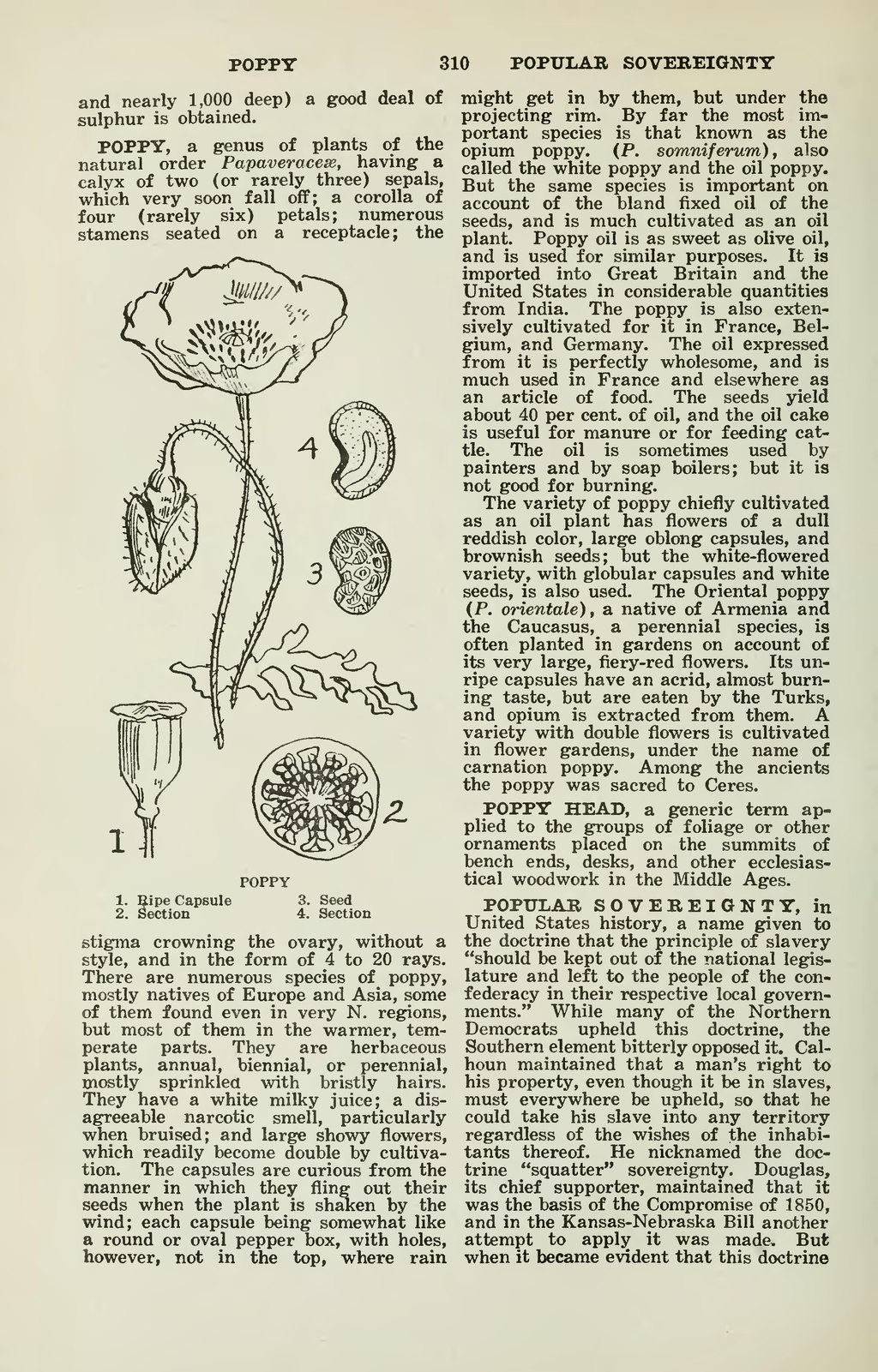POPPY 310 POPULAR SOVEREIGNTY and nearly 1,000 deep) a good deal of sulphur is obtained. POPPY, a genus of plants of the natural order PapaveraccBe, having a calyx of two (or rarely three) sepals, which very soon fall off; a corolla of four (rarely six) petals; numerous stamens seated on a receptacle; the POPPY 1. Eipe Capsule 3. Seed 2. Section 4. Section stigma crowning the ovary, without a style, and in the form of 4 to 20 rays. There are numerous species of poppy, mostly natives of Europe and Asia, some of them found even in very N. regions, but most of them in the warmer, tem- perate parts. They are herbaceous plants, annual, biennial, or perennial, mostly sprinkled with bristly hairs. They have a white milky juice; a dis- agreeable narcotic smell, particularly when bruised; and large showy flowers, which readily become double by cultiva- tion. The capsules are curious from the manner in which they fling out their seeds when the plant is shaken by the wind; each capsule being somewhat like a round or oval pepper box, with holes, however, not in the top, where rain might get in by them, but under the projecting rim. By far the most im- portant species is that known as the opium poppy. (P. somniferum) , also called the white poppy and the oil poppy. But the same species is important on account of the bland fixed oil of the seeds, and is much cultivated as an oil plant. Poppy oil is as sweet as olive oil, and is used for similar purposes. It is imported into Great Britain and the United States in considerable quantities from India. The poppy is also exten- sively cultivated for it in France, Bel- gium, and Germany. The oil expressed from it is perfectly wholesome, and is much used in France and elsewhere as an article of food. The seeds yield about 40 per cent, of oil, and the oil cake is useful for manure or for feeding cat- tle. The oil is sometimes used by painters and by soap boilers; but it is not good for burning. The variety of poppy chiefly cultivated as an oil plant has flowers of a dull reddish color, large oblong capsules, and brownish seeds; but the white-flowered variety, with globular capsules and white seeds, is also used. The Oriental poppy (P. orientale) , a native of Armenia and the Caucasus, a perennial species, is often planted in gardens on account of its very large, fiery-red flowers. Its un- ripe capsules have an acrid, almost burn- ing taste, but are eaten by the Turks, and opium is extracted from them. A variety with double flowers is cultivated in flower gardens, under the name of carnation poppy. Among the ancients the poppy was sacred to Ceres. POPPY HEAD, a generic term ap- plied to the groups of foliage or other ornaments placed on the summits of bench ends, desks, and other ecclesias- tical woodwork in the Middle Ages. POPULAR SOVEREIGNTY, in United States history, a name given to the doctrine that the principle of slavery "should be kept out of the national legis- lature and left to the people of the con- federacy in their respective local govern- ments." While many of the Northern Democrats upheld this doctrine, the Southern element bitterly opposed it. Cal- houn maintained that a man's right to his property, even though it be in slaves, must everywhere be upheld, so that he could take his slave into any territory regardless of the wishes of the inhabi- tants thereof. He nicknamed the doc- trine "squatter" sovereignty. Douglas, its chief supporter, maintained that it was the basis of the Compromise of 1850, and in the Kansas-Nebraska Bill another attempt to apply it was made. But when it became evident that this doctrine
Page:Collier's New Encyclopedia v. 07.djvu/376
This page needs to be proofread.
LEFT
310
RIGHT
